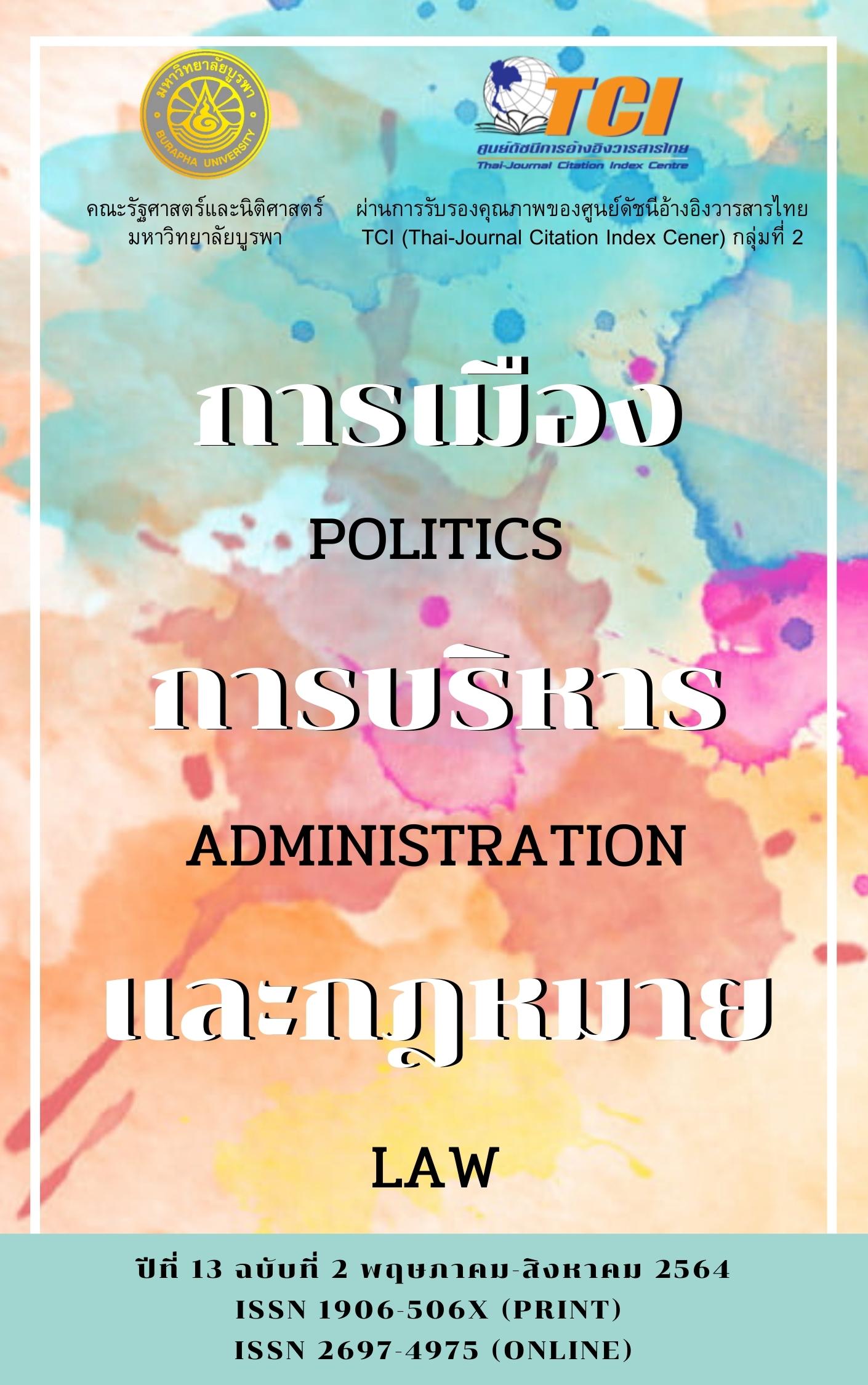The Guidelines for Creating Innovation in Organizations in Automotive Industry in Eastern Economic Corridor (EEC)
Keywords:
Creating innovation, Automotive industry, Eastern Economic Corridor (EEC)Abstract
Research on the guidelines for creating innovation in organizations in automotive industry in Eastern Economic Corridor (EEC) had objectives to study the ways of creating innovation among the operational staff, skill groups In the automotive industry The study was a quantitative research with 220 companies. The statistics used in the research was analysis of the structural equation model (SEM) with statistical significance at the level of .05 using Mplus V.8 program. The results showed that the first guideline for creating innovation in the organization was the behavioral behavior of staff at work level and at the individual level (β = .591), and the 2nd guideline was the clear target (β = .552). The 3rd was the creation of added value (β = .547).
References
จิตรลดา พิศาลสุพงศ์ และสุพัตรา ศรีภูมิเพชร. (2560). การพัฒนาวิทยาศาสตร์ เทคโนโลยี วิจัย และนวัตกรรม. วารสารเศรษฐกิจและสังคม สำนักพัฒนาขีดความสามารถในการแข่งขันทางเศรษฐกิจ, 54(1), 50-54
เทพรัตน์ พิมลเสถียร. (2560). นวัตกรรมกับการบริหารทรัพยากรมนุษย์: กรณีศึกษาผู้ประกอบการแฟชั่นระดับลักเซอร์รี่ ในประเทศไทย. วารสารการเมือง การบริหาร และกฎหมาย, 9(3), 203
นพดล เหลืองภิรมย์. (2557). การจัดการนวัตกรรม (พิมพ์ครั้งที่ 2). กรุงเทพฯ: ดวงกมล.
ประชุม รอดประเสริฐ. (2528). การบริหารโครงการ. กรุงเทพฯ: โรงพิมพ์เนติกุลการพิมพ์.
พระราชกฤษฎีกาจัดตั้ง สำนักงานนวัตกรรมแห่งชาติ (องค์กรมหาชน), (2563, 23 มิถุนายน). ราชกิจจานุเบกษา. เล่ม 137 ตอนที่ 46 ก.
พูลพงศ์ สุขสว่าง. (2557). หลักการวิเคราะห์โมเดลสมการโครงสร้าง. วารสารมหาวิทยาลัยนราธิวาสราชนครินทร์, 6(2), 136-145.
ศิวพร โปรยานนท์. (2554). พฤติกรรมของผู้นำและสภาพแวดล้อมการทำงานที่ส่งผลต่อความ สร้างสรรค์ในงานบุคลากร กรณีศึกษา องค์การธุรกิจไทยที่มีนวัตกรรมยอดเยี่ยมปี 2552. วิทยานิพนธ์วิทยาศาสตรมหาบัณฑิต, การพัฒนาทรัพยากรมนุษย์และองค์การ, คณะพัฒนา ทรัพยากรมนุษย์, สถาบันบัณฑิตพัฒนบริหารศาสตร์.
เศรษฐชัย ชัยสนิท. (2553). นวัตกรรมและเทคโนโลยี. วันที่ค้นข้อมูล 3 มีนาคม 2562, เข้าถึงได้จาก http://it.east.spu.ac.th/informatics/admin/knowledge/A307Innovation%20and% 20Technology.pdf
สำนักงานคณะกรรมการนโยบายเขตพัฒนาพิเศษภาคตะวันออก(สกพอ.). (2561). อุตสาหกรรมยานยนต์สมัยใหม่. วันที่ค้นข้อมูล 3 มีนาคม 2562, เข้าถึงได้จาก https://www.eeco.or.th/th/next-generation-automotive-industry
สำนักงานนวัตกรรมแห่งชาติ(สนช.). (2562). การจัดการนวัตกรรมสำหรับผู้บริหาร. วันที่ค้นข้อมูล 3 มีนาคม 2562, เข้าถึงได้จาก http://www.nia.or.th
สำมะโนธุรกิจอุตสาหกรรม. (2555) วันที่ค้นข้อมูล 3 มีนาคม 2562, เข้าถึงได้จาก http://service.nso.go.th/nso/web/ census/bussindustry.html
สุนันทา เลาหนันท์. (2542). การบริหารทรัพยากรมนุษย์. กรุงเทพฯ: สถาบันราชภัฏบ้านสมเด็จเจ้าพระยา.
อารมณ์ ริ้วอินทร์. (2556). การเงินธุรกิจ. กรุงเทพฯ: สำนักพิมพ์มหาวิทยาลัยกรุงเทพ.
Amabile, T. M. (1997). Motivating Creativity in organizations: on Doing What You Love and Loving What You Do, California Management Review, 40(1), 39-58.
Anderson, N., De Dreu, C. K.W.; & Nijstad, B. A. (2004). The Reutilization of Innovation Research: a Constructively Critical Review of the State-o-the-science. Journal of Organizational Behavior, 25, 147-173.
Chan, S., Ang, S., Andleeb, N., Ahmad, M., & Zaman, I. (2018). The Influence of Transformational Leadership on Organization Innovation in Malaysian Manufacturing Industry. Int. J Sup. Chain. Mgt, 8(2), 971-976.
Chen, T. (2019). Establishment of Competency Model for Middle Managers in Hotel. Advances in Economics, Business and Management Research, 85, 787-793.
Curral, L. A., Forrester, R. H., Dawson, J. F.; & West, M. A. (2001). It’s What You Do and the Way Thai You Do It: Team Task, Team Size, and Innovation-Related Group Processes. European Journal of Work and Organizational Psychology, 10(2), 187-204.
Damanpour, F. 1987, “The Adoption of Technological, Administrative, and Ancillary Innovations: Impact of Organizational Factors”. Journal of Management, 13(4), 675-688.
De Jong, J. P. J., & Den Hartog, D. N. (2010). Measuring Innovative Work Behavior. Creativity and Innovation Management, 19, 97.
Ding, L., Velicer, W. F., & Harlow, L. L. (1995). Effects of estimation methods, number of indicators per factor and improper solutions on structural equation modeling fit indices. Structural Equation Modeling, 2(2), 119-143.
Dosi, G. (1982). Technological paradigms and technological trajectories: A suggested interpretation of the determinants and directions of technical change. Brighton U.K.: Science Policy Research Unit, University of Sussex.
Fagerberg, J. (2005). Innovation: A Guide to the Literature. Oxford: Oxford University Press
Herkema, S. (2003). A Complex Adaptive Perspective on Learning within Innovation Projects. The Learning Organization, 10(6), 340- 346
Kanter, R. M. (1983). The change master: Innovation and Entrepreneurship in the American corporation. New York: Simon and Schuster
Kash, D. E. (1989). Perpetual Innovation: The New World of Competition. New York: Basic Books.
Kiani, M., Ahmad, M., & Gillani, S. (2019). Service innovation capabilities as the precursor to business model innovation: a conditional process analysis, Asian Journal of Technology Innovation. Retrieved March 3, 2019, from https://www.tandfonline.com/loi/rajt20
McFadzean, E. (2001). Jones and McFadzean, 1997. Strategic Change, 10, 267.
Morton, J. A. (1971). Organization for Innovation: A Systems Approach to Technical Management. New York: McGraw-Hill.
Mulligan, B. (2020). Economic Activity and the Value of Medical Innovation during a Pandemic. NBER Working Paper No. 27060, Department of Economics, University of Chicago. JEL No. E01, I18,O31.
Parker, S. K., Williams, H. M., & Turner, N. (2006). Modeling the antecedents of proactive behavior at work. Journal of Applied Psychology, 91(3), 636-652.
Paulus, P. B. (2000). Group, Teams and Creativity: The Creative potential of idea generating groups. Applied Psychology: An international Review. 49, 237-262.
Porter, M. E. (1990). The Competitive Advantage of Nations. London: Macmillan.
Rogers, E., & Shoemaker, F. (1978). Communication of innovations: A cross-cultural approach. New York: Free Press.
Schumacker, R. E., & Lomax, R. G. (2016). A beginner’s guide to structural equation Modeling (4th ed.). New York: Taylor & Francis.
Thahira, A., Tjahjono, K., & Susanto, S. (2020). The Influence of Transactional Leadership on Organization Innovativeness (OI) Mediated by Organizational Learning Capability (OLC) in Medium Small Enterprise Kendari City. Jurnal Manajemen Bisnis, 11(1), 90-104.
Thomas, P. H. (1985). A Century of Invention and Technological Enthusiasm. American Genesis.
Vrakking, W. J. (1990). The Innovative Organization. Long Range Planning, 23(2), 94-102.
Vukovic, A., Damnjanovic, J., Papic-Blagojevic, N., Josanov-Vrgovic, I., & Gagic, S. (2018). Impact of Leadership on Innovation: Evidence from the Hotel Industry. Journal of Sustainable Business and Management Solutions in Emerging Economies, 23(3), 57-66.
White, M. A., & Bruton, G. D. (2007). The Management of Technology and Innovation: A Strategic Approach. Boston, MA: Cengage Learning Publishing.
Downloads
Published
Issue
Section
License

This work is licensed under a Creative Commons Attribution-NonCommercial-NoDerivatives 4.0 International License.






